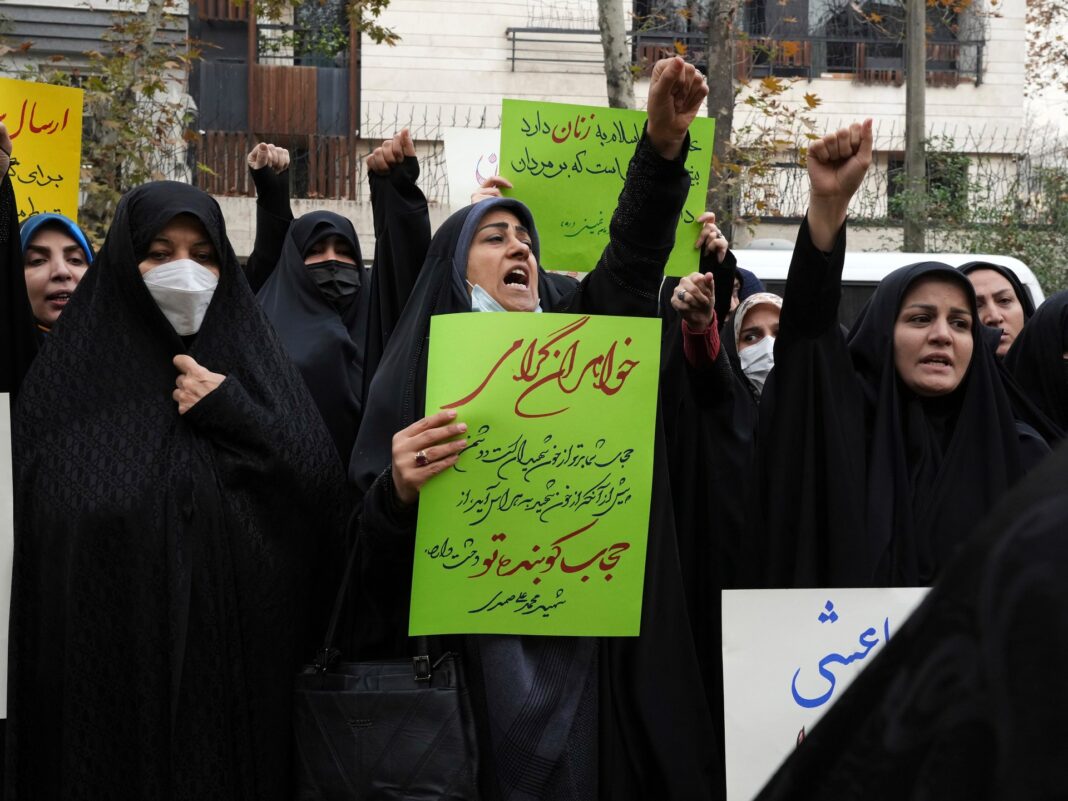Tehran, Iran – In a first, Iranian authorities have dispersed a demonstration calling for stricter implementation of the country’s dress code rules.
On Friday evening, after state-organised Quds Day rallies in support of the Palestinian cause ended, police dispersed dozens who had been camping out in front of the parliament for weeks.
The demonstrators, mostly women clad in full-body black chadors, had been there for nearly 50 days to decry what they view as loose enforcement of mandatory hijab, which signifies the abandonment of “Islamic values” to them.
Women and men in Iran are bound by a law passed shortly after the country’s 1979 revolution to adhere to strict dress codes – including a veil covering hair for women – on pain of prison, flogging, or financial penalties.
Why the fight over hijab?
For decades, Iranian authorities have enforced the mandatory hijab through patrols by police and security forces.
The country’s so-called “morality police”, known as “Gasht-e Ershad” or Islamic guidance patrol, would round up people on the streets for “undermining public decency” and put them in vans to be “re-educated” at designated centres or be punished through the courts.
That is what happened to 22-year-old Kurdish woman Mahsa Amini in September 2022, who was arrested in Tehran for alleged non-compliance with hijab laws while out with her family.
She died in police custody, her death triggering nationwide protests for months. Hundreds of protesters and dozens of security forces were killed in the unrest, with authorities saying the United States, Israel, and other rivals were behind the “riots”.
The hijab has since become an increasingly hot-button topic.
Iranian authorities announced they would suspend the morality police in late 2022, but the force’s white vans soon made a comeback to the streets of Tehran and other major cities.
Many more women and men have been arrested or had cases opened against them for dress code-related offences. This has ranged from average Iranians on the streets to journalists and veteran actresses who appeared unveiled in public, and businesses or even taxi drivers whose customers were deemed to be violating the law.
Controversy over hijab bill
Faced with increasing hijab-related “crimes”, especially in Tehran, where many women go out without a headscarf, Iranian authorities have been trying to implement new legislation that would boost their authority to crack down on offenders.
A new hijab bill that defines heavy punishments, especially ramped-up financial penalties, was passed by Iran’s conservative-dominated parliament in September 2023, under the administration of late President Ebrahim Raisi.
It was then discussed in top state bodies many times, before finally being backed in September 2024 by the Guardian Council, the 12-member constitutional watchdog that has to greenlight legislation before it can be implemented.
But President Masoud Pezeshkian, who has pledged to pursue mandatory hijab through non-confrontational methods like “education”, said his government would be incapable of enforcing the “impractical” bill.
After much speculation, conservative parliament chief and former military commander Mohammad Bagher Ghalibaf finally confirmed in March that the Supreme National Security Council (SNSC) had ordered the bill’s implementation halted.
The council agreed that the bill “could cause tensions in today’s society” in the aftermath of the 2022-23 protests, Ghalibaf told state media, adding that the government and parliament are working on finding ways of enforcing it in the future.
In the meantime, as authorities battle a budget crunch under sanctions pressure from United States President Donald Trump, they have launched new efforts to crack down on hijab offences.
They have set up cameras in public spaces to identify and punish unveiled women, allowed people to report others – and their vehicles, which could be impounded – for hijab offences without providing evidence, and imposed heavy fines or shuttered violating businesses.
Why confront pro-hijab voices?
The dozens, and sometimes hundreds, of women demonstrating in front of the parliament have been making headlines for weeks.
Some local media called them “super-revolutionaries” due to their religious zeal, and they have garnered praise and support from ultraconservative factions within the Iranian establishment.
They, along with several hardline legislators in parliament, have been accusing the parliament chief and the president of complacency over the enforcement of the hijab bill.
They have described mandatory hijab as a tenet of Iran’s theocratic establishment that “enemies” wish to trample.

But Tehran Governor Hossein Khosh-Eghbal said on Saturday that the demonstrations were “illegal” and warned that police would disperse any further protests held without permits.
He did not mention why the demonstrations were tolerated for weeks, or comment on claims, including by conservative legislator Javad Nikbin, that the demonstrators were paid to be there and had been bused in.
Police confirmed that many of the women had travelled from the holy Shia city of Qom, some 150km (90 miles) south of Tehran.
They also broadcast a short video via state media that showed their officers trying to reason with the shouting protesters and explain why they must disperse by law before taking action.
In a viral video filmed by one of the protesters and circulated online, the woman behind the camera can be heard screaming and saying 400 male and female officers descended on them, put them in vans and dropped them in different parts of Tehran to disperse them.
The woman showed another chador-clad woman lying on the ground with a bloody face, claiming demonstrators were beaten.
The state-run Fars news agency reported that police used “physical means” to end the protests and left demonstrators on the outskirts of the city in the middle of the night.
Police said the video was “staged” in an attempt to influence public sentiment, and that the wounds were self-inflicted.
Politicians with the Paydari (Steadfastness) Front, the ultraconservative faction whose presidential candidate Saeed Jalili was defeated in elections last year, have been lambasting the decision.
Hamid Rasaei, a top hardline legislator with the faction, said whoever decided to disperse the protesters did it “either out of foolishness or due to infiltration”.


